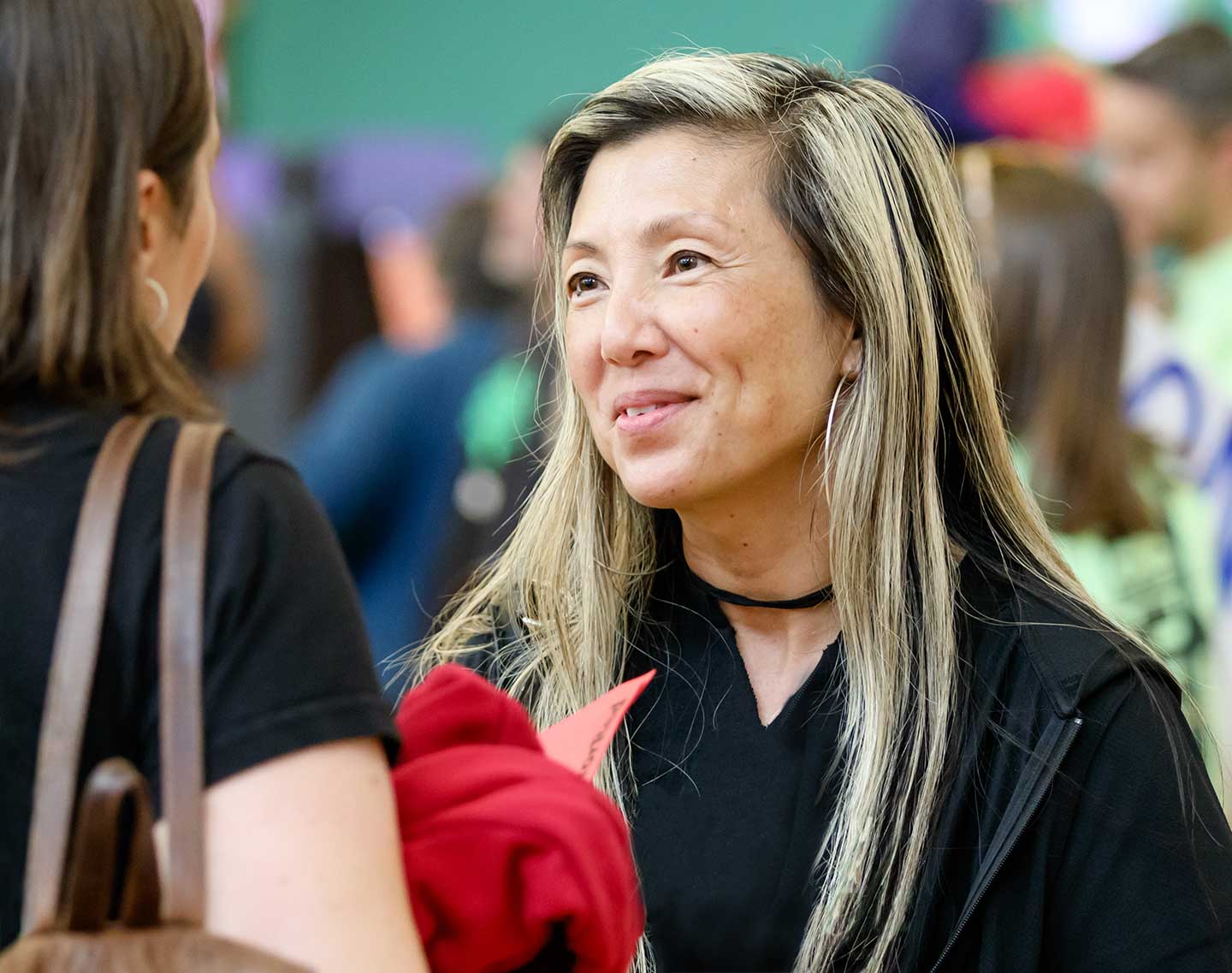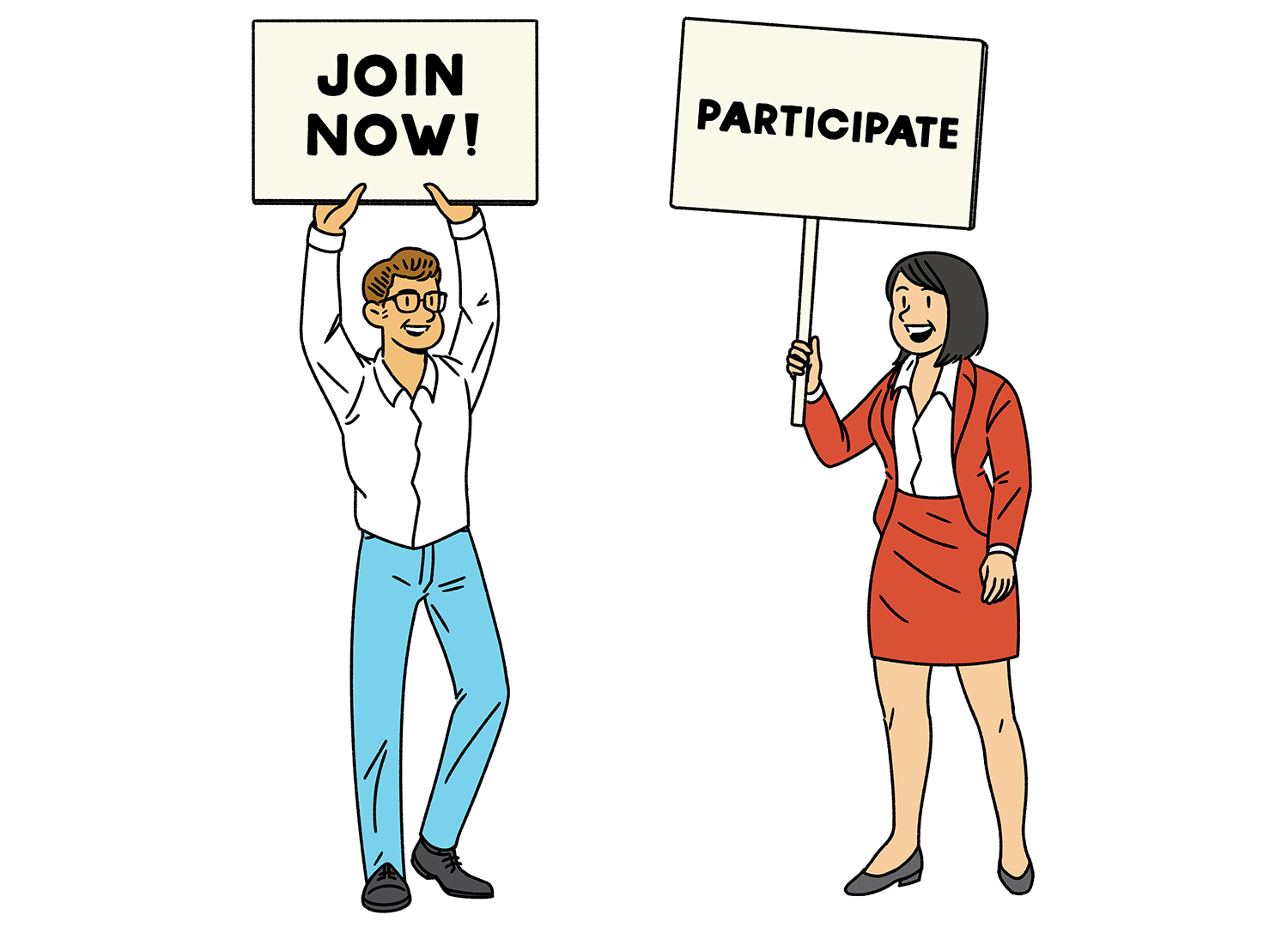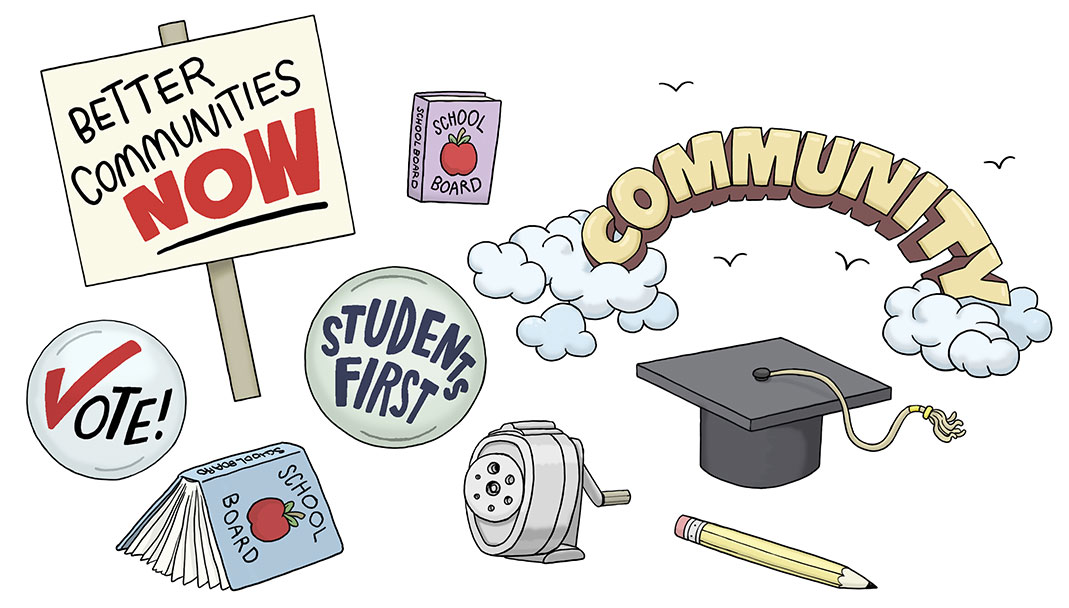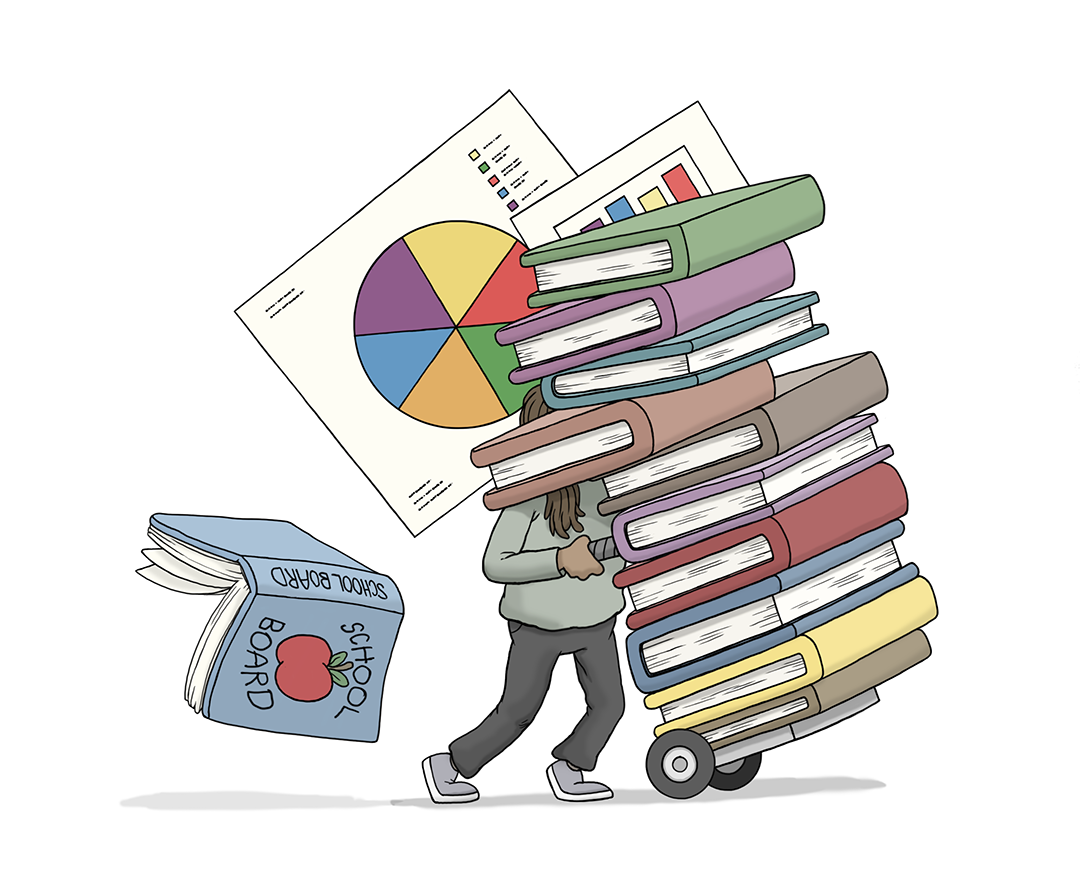HOW TO RUN FOR SCHOOL BOARD
It can start
with just
ONE.

THE POWER OF ONE
Redesigning high schools to improve student achievement and prepare students for life is a collective responsibility. It requires local effort, led by parents, teachers, students, and community members like you, working together with one another and with the superintendent to deliver meaningful, lasting change.
But it can start with just ONE person sparking the discussion.
ONE person raising the priorities and asking the right questions.
ONE person reaching out to friends and neighbors to build a coalition that energizes a community movement.
You can be that person.
The health of a community depends on the health of its local high schools— and vice versa. If you choose to “run to serve” your hometown and neighborhood as a potential member of your local school board, you can put the spotlight squarely on the issues and solutions that really matter: high schools that truly prepare young people for the challenges of the future.
Win or lose, a candidate who advocates for rethinking high school in election season is a gain for us all.

Become An Engineer for Change

SCHOOL
BOARD.
YES, YOU.
Now more than ever before, people are calling for change. That’s why voters all across the country are calling upon the president, their members of Congress, their governors and state officials, their local town council, and other elected leaders to improve their communities and states, not to mention the nation and the world, in tangible ways.
You might be asking yourself: What can I do? And the answer just might be: Run for school board. Yes, you.
School boards comprise everyday people—no prerequisites, no out-of-reach qualifications needed.
You don’t need a background in education policy. You don’t need to have experience in local government. And you don’t need to have kids in the school district.
What matters most is your own deep commitment to seeing the young people in your community get the best possible high school education—the kind of high school education that can carry every one of them forward into a rewarding future.
Start with commitment, and you’ll set the tone for success.
The most important qualification is a willingness to advocate for the students in your district. The second is the ability to listen. After all, school board members are responsible not only for making decisions that improve schools but also for incorporating the needs, priorities, and consensus of the community.
By resetting and reshaping high school priorities, every school board candidate can change students’ lives—and the trajectory of an entire community.

School Board Stories:
CIPRIANO VARGAS
Vista Unified School District, California
“School leaders have the responsibility to measure beyond graduation rates and college-bound numbers. We need to ensure that the content within a high school prepares students beyond graduation and allows them to thrive in any setting, whether it’s a four-year university, a technical school, the military, or the workplace.”
Cipriano is the first member of his family to earn a college degree and at age 24 was the youngest person to be elected to Vista’s school board. Throughout his 2016 campaign, he emphasized the need to focus on preparing students for future success.
“We need to make sure that our students are reading and writing at grade level in high school and throughout the K-12 system, and that they’re not falling behind so that when we send our students off to college, we aren’t setting them up for failure,” Cipriano said in a campaign video.
Cipriano also believes that, in a changing world, students’ future depends on a grounding more expansive than traditional academics alone: “I want to ensure students have the skills necessary to succeed in the 21st century. This includes cultural competency, and the skills sought after in the workforce.”
How to Make High School Part of Your Platform

INCLUDE HIGH SCHOOL REDESIGN IN YOUR PLATFORM
Better high schools make for better equipped high school students. Better equipped high school students make for better prepared high school graduates. And better prepared high school graduates ultimately make for great neighbors, colleagues, parents, and members of society as a whole. And so, when we talk about the kind of country and communities we want to live in, it makes sense to start by talking about our high schools.
They say success is what happens when preparation meets opportunity. Successfully making high school redesign a centerpiece of your campaign requires that you learn more about the schools in your community. And that means learning about what’s going right, wrong, and everything in between.
START BY GATHERING THE FACTS
A reverence for the facts, for data, for substantial evidence—no matter where it leads—not only strengthens your own command of the issues, but also sends a strong signal to voters that you’re well-versed on the community’s needs and passionate about the opportunity to improve our schools. Facts may be stubborn things… but they’re also the building blocks of school board campaigns and the catalysts for positive change.
REVIEW YOUR WORK
This is a good time to look back at the answers you uncovered in Workbooks 1 and 2.
If you haven’t done so already, it’s time to answer those questions about your district and your community.
Remember, they’re designed to make you a more knowledgeable and thoughtful school board candidate and to help you prepare for questions you’ll surely get on the campaign trail.

SEARCH FOR SOLUTIONS
Once you understand the facts, you can start thinking about why problems exist, why those problems matter, and why they may be hard to change. From there, you can start searching for potential solutions that will actually work and stick.
Educating yourself about what can actually be done will make you a better candidate. It will help you discover what you personally believe is right. And it will help raise the level of discussion of the whole election.
Think
Examine the Issue
I can’t help but notice a lot of school-aged teenagers outside of the classroom during the school day. It seems to me that my neighborhood high schools don’t have the steady attendance records I would expect. Am I onto something?
Question
Why it Matters
Simply put, students who aren’t in school can’t learn. Poor attendance can be a warning sign that a student is disengaged and in danger of dropping out, or it can signal problems outside of school that need attention. It can also be a sign that a student needs better instruction.
Look
To Find Answers
A useful resource for solving attendance problems is Attendance Works a national nonprofit that helps states and localities tackle this difficult problem. Here you’ll find advice on strategies that work, stories from schools that have improved attendance, and tools for analyzing your data.
Think
Examine the Issue
The high schoolers I know often complain about ‘being bored’ in the classroom—that they find the work too easy and unstimulating. These are smart kids, so I asked them about looking into Advanced Placement, International Baccalaureate, or dual enrollment opportunities. Their response? That they don’t qualify. What gives?
Question
Why it Matters
Students deserve to be intellectually challenged. And one of the best ways to add rigor to high school curricula is through college-level coursework, including AP, IB, or dual enrollment with a local college. These classes offer students a head start on college—often saving their families many thousands of dollars in tuition later on—and demonstrably improve their chances of on-time graduation.
Look
To Find Answers
More than three-quarters of American high schools offer one or more AP courses, and many others offer either IB or dual enrollment opportunities. For schools that don’t have programs like this, the obvious next step is to start them. Learn more about how they work from the College Board (for AP), the IB Diploma Programme, or a local college.
For schools that do have these programs, the next step is to expand offerings and participation by reducing unnecessary barriers like GPA or teacher recommendation requirements. If students want to challenge themselves academically, why should their schools stop them?
For schools, especially in rural areas, where access to advanced coursework is impractical, technology can open new doors of opportunity. Consider using online courses or virtually connecting to other schools that are offering these programs. Courses like this are offered through various platforms, including edX.
Think
Examine the Issue
My local public high school has a reputation—and it’s not good. It’s been labeled a “dropout factory” because of its chronic low graduation rates and high dropout rates. I know this is a big problem, but it seems hopeless. Does anyone really know how to fix it?
Question
Why it Matters
Young people without a high school diploma have few options—either for good jobs or for furthering their education. The average dropout earns $27,000 per year. That’s a lot less than the $36,800 average for high school graduates and the $61,400 average for those with a bachelor’s degree. Over a career, these differences in pay accumulate to tens, even hundreds of thousands of dollars.
Look
To Find Answers
If low graduation rates are an issue in your district, try talking to students to understand the problem from their perspective. Once you grasp what students are experiencing, look for potential solutions from these three excellent resources: Johns Hopkins University’s Everyone Graduates Center, the National Dropout Prevention Center, and the College and Career Readiness Center.

CRAFT A POWERFUL CAMPAIGN NARRATIVE
Every community is unique, with its own distinctive strengths and weaknesses, points of pride, and pain points. And so, you’ll need to find a unique way to talk about the importance of high school redesign in a way that resonates with local voters.
Only by listening to—and learning from—students, parents, educators, experts, and other constituents can you use your candidacy to advocate for the types of change that make sense for your high schools, your neighborhoods, your community.
Once you’ve grounded yourself in data points and best practices, heard from students and neighbors, and explored your own personal beliefs about high school, you’ll have the ingredients you need to craft the beginning of a campaign narrative. A narrative that weaves together why you care, what you know, and how you propose to make a difference.
A narrative that forms the foundation of a school board candidate speech… a personal website… an entire platform. In short, you’ll have all the ingredients to start making your own compelling case for change.

School Board Stories:
TOMEKA HART
Memphis City Schools, Tennessee
“Initially, I did what everyone does. I thought, ‘Somebody needs to run!’ After a while, the thought turned to ‘Why don’t I run?’ I spent time trying to talk myself out of running. In time, I realized I couldn’t. I wanted to be part of the solution... I wanted to contribute my time and talent in service of my school system.”
As a former teacher who spent five years teaching middle and high school students, Tomeka never planned or even thought about running for office. That is, until she started paying attention to local politics, especially her local school board, and discovered that there was little focus on the problem of low student achievement. Once elected, Tomeka led an effort to create the Memphis school system’s first Office of the General Counsel—saving the district millions of dollars. Her commitment to improving academic outcomes for students sometimes meant pushing for policies and practices that some deemed controversial, but she used her influence as a board member to help bring about needed change, no matter how hard. Under her leadership as school board president, the board transformed its own activities—ranging from how it evaluated the superintendent’s performance to how strongly it prioritized student achievement.
Workbook 3.
DEFINE YOUR MESSAGE & STRATEGY
This section will help you go piece by piece to take a big task—articulating your reasons for running—and break it down into its component parts. Your writing here can inform a stump speech—a tool you can use to reach out to and resonate with voters and volunteers while on the campaign trail.

School Board Stories:
KELSEY WAITS
Hastings Public Schools, Minnesota
“The hardest part for me was taking that first step and filing to run for office. I had convinced myself that I was ‘unelectable.’ I was a homeschooler, I was too young, and I was too new to our small community to pull off a victory. Once I was able to set those fears aside, I jumped in, campaigned hard, and won one of the three open seats.”
For Kelsey Waits, the inspiration to run for her local school board began with the Women’s March in her hometown of St. Paul, Minnesota. “We had close to 100,000 marchers, and experiencing the power of all those voices coming together was amazing. I wanted to be a part of carrying that power forward and working toward making a difference in my community.”
Kelsey’s passion for advocacy started at home with her family. “I’m a statistician turned stay-at-home-mom. When I decided to run, my youngest child had just started in special-education speech therapy courses at our public preschool, and my oldest daughter was being home-schooled due to special needs.”
With an eye on the future, she wanted to be sure the local public schools would be prepared to serve all kids all the way through high school. Her work leading the Diversity, Equity, and Inclusion Initiative spearheaded jointly by her city council and school board led to a local proclamation affirming that “All are Welcome” in their community.
Turning
Supporters
Into Partners
INCLUDE THE COMMUNITY
Yes, as a candidate, launching a campaign calls for you to talk about yourself, your background, your beliefs, and your vision for the future. And hopefully, with the practice of starting a campaign narrative, you’ll grow increasingly confident about doing just that. But as bridges between the community and the classroom, school board members— and candidates—have an obligation to encourage a dialogue that goes both ways. And that means knocking on doors to uncover the pulse of neighborhoods. It requires drawing out the frustrations of struggling students in an open forum. It calls for not only landing strategic endorsements but creating effective partnerships.
What do parents of high school students really think about your local high schools? What do parents think schools are getting right and wrong? What do teachers and administrators want parents and community members to know?
Find out—and then create a campaign that’s powered by their enthusiasm.
What skills are local employers and college officials looking for from the young people who graduate from your schools?
Discover what matters most and partner with local businesses to get the word out!
Above all, what do the students themselves think about their day-to-day experiences? Do they feel they’re getting what they need to be successful in college and the careers that interest them?
Invite students to an informational session, where they give their input and you teach them about how school board members can create change. Pass the torch.
The best part? As you listen, you learn. You gather real stories that can strengthen your narrative through examples. Stories you can use to make a point, challenge the status quo, or illustrate the difference a policy change can make. Stories are the perfect vehicle for communicating change precisely because they bring numbers, facts, and hard truths to life through the human experience. That’s why every statistic you cite should always have a human component drawn directly from the students, parents, and teachers you talk to.
MAKE YOUR CAMPAIGN STAND OUT
A campaign that’s about the future shouldn’t feel like all the campaigns of the past. Make yours an example of transformative thinking by integrating the kind of creativity and problem-solving we want students to learn. Let your local knowledge spur your innovation. The possibilities for you to tailor your campaign to your values, your beliefs, and your strengths are limitless—if you’re trying to break the mold of high school design, start by thinking outside of the box when it comes to your own school board campaign. Here are some ideas to help your campaign stand out
Recruit a Campaign Student Council
Think about recruiting a group of impassioned high school students to counsel you and serve as a sounding board for your ideas—not only about education but about your campaign. Promote your student council and their ideas in your campaign materials.
Host a Candidate’s Lunch
Candidate debates and discussions are often held during the evening when it’s inconvenient for students and even some parents to attend. Think about asking local high schools to host a candidates’ event during the lunch hour in the school auditorium, so hundreds of students can see, listen to, and provide ideas to all the school board candidates.
A Different Kind of Campaign Brochure
What if, instead of a traditional campaign brochure, you included a link to a community survey in your initial flyer? The survey would give community members a chance to reflect on their goals for local young people, and how well they think your high school is serving its students. You can report back in future campaign literature.
A Cabinet of Local Experts
In addition to your core campaign committee, consider recruiting a “cabinet” of people who share your commitment to high school transformation and are willing to work to make it happen. Your cabinet might include a Secretary of Employer Partnerships, a Secretary of Student Engagement, a Secretary of Equity, a Secretary of Postsecondary Learning, and other key roles.
HOW TO WIN YOUR SCHOOL BOARD ELECTION
Redesigning high schools to improve student achievement and prepare students for life is a collective responsibility. It requires local effort, led by parents, teachers, students, and community members like you, working together with one another and with the superintendent, to deliver meaningful, lasting change.
But it can start with just ONE person sparking the discussion.
ONE person raising the priorities and asking the right questions.
ONE person reaching out to friends and neighbors to build a coalition that energizes a community movement.
You can be that person.
The health of a community depends on the health of its local high schools— and vice versa. If you choose to “run to serve” your hometown and neighborhood as a potential member of your local school board, you can put the spotlight squarely on the issues and solutions that really matter: high schools that truly prepare young people for the challenges of the future.
Win or lose, a candidate who advocates for rethinking high school in election season is a gain for us all.
Create materials that grab—and hold—public attention
Whether they’re displayed on lawns, taped in store windows, or flashed across social media, campaign signs are typically uniform: the candidate’s name, the position they’re running for, maybe a decorative flourish or two. Not memorable in any way. But you can design your campaign materials to spark a meaningful conversation about the importance of improving the district and your community. For example:

Gather endorsements
From businesses. From your local newspaper. From administrators, teachers, and community figures you respect. Endorsements signal both validity and tenability to other voters. They are something you can promote on your website, on the campaign trail, and in day-to-day conversations. All of a sudden it’s not “take my word for it,”… it’s “take our word for it.”

Lean on personal and professional networks
Winning campaigns is about activating the social influence you already have as much as it is about creating new networks. Family, friends, colleagues—if you believe in your cause, these are all available resources to who you should feel comfortable asking for support.
Does your colleague participate in a sports league? Ask him or her if you can introduce yourself at a game. Does your favorite local coffee shop have a bulletin board? Ask if they’d allow you to advertise your next campaign forum. Does your cousin run a business council? Ask him or her if you can take five minutes of the committee’s time to explain why school boards matter—and how as a school board member, you’d work to strengthen the relationship between the high school and the local economy.

Balance personal appearances and social media presence
There’s no doubt that social media has changed races for public office—even on a local level. But it doesn’t have to be all or nothing. When a phone has the power to record video, why not ask a campaign team member to capture an “in-person” appearance—whether during a speech, in a listening forum with students, or while out canvassing. Social media at its best amplifies your real, interpersonal connections with community members—it doesn’t replace them.

Go on, GOTV!
Too often, school board elections suffer from a lack of voter turnout simply because they don’t coincide with bigger political races. So why not draw attention to them? Get-out-the-vote efforts are all about increasing voter turnout. They draw attention to a race instead of a particular candidate. And because we all win when more people get involved with their local school board, they’re a great way for any team to spotlight the issues that matter most to them. Go on, GOTV!
It takes just ONE person to ask the questions, raises the priorities, and frame the kind of debate that can energize and mobilize a community movement. All it takes is ONE person to kick-start a process that may change students’ lives, even change the trajectory of an entire community.
One person. One decision.
One campaign.
The power of one is the power of you.